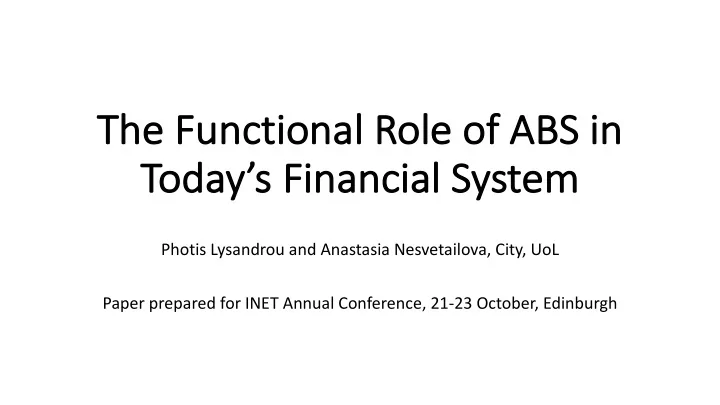

The Funct ctional Role of ABS in Today’s Financi cial System Photis Lysandrou and Anastasia Nesvetailova, City, UoL Paper prepared for INET Annual Conference, 21-23 October, Edinburgh
DEBT T Global debt levels at all time high ($217 trillion), or 325% of the world’s GDP. The aggregate figures conceal many forms of debt, including as financial instruments. Securitisation-based products finance about 20% of global capital markets needs; in the US it is 30% annually and 40% historically (Moody’s 2017).
Asse Asset-Ba Backed Se Securi rities s (ABS) (ABS) Bonds that finance pools of familiar asset types, such as auto loans, aircraft leases, credit card receivables, mortgages, and business loans .
Collateralised Debt Obligations
Today: CLOs
Two main reasons why investors are directed into more complex and risky securities 1. Tight post-2009 regulatory constraints are preventing the rate of ABS supply from keeping up with investor demand. 2. Intellectual/doctrinal. Regulators do not appear to understand the functional role of ABS in the financial system today.
St Stock of Global Financial Assets
Th The Dual Function of Bonds 1. As a financial instrument for the issuing entity (governments, banks, corporations, universities, etc.). 2. As an investable security. This function is key to large institutional investors (pension funds, insurance companies, endowments, money managers etc.).
Investors give money when purchasing the bond, but in the meantime they use bonds for conservation purposes : as value storage containers into which clients’ monies can be poured and from which money can be extracted to repay the clients. We do not know much about this second function of bonds.
Global AuM: Growth Index Mainstream economics has never really accommodated the nuances of the financial system (Minsky, Mehrling). There have been profound changes in the organisation of the AM sector. Again, they are not reflected in theory or models.
Many factors behind the rise of AM Reform of universal pension and welfare => High to mid-income households are more yield-oriented. They rely less on bank forms of provision and more on the capital markets. While being risk-averse.
Household gross financial wealth by asset type (Euro area)
Institutional Investors Need to accommodate the ever increasing inflow of funds. They tend to prefer bonds, rather than equities. “De-equitisation” (Haldane 2014)
From the point of view of institutional investor Bonds pay interest by law, not by discretion They are able to conserve value as long as their prices are maintained at a stable level => the function of ABS
De Deman and an and S Supply ly o of B Bonds The supply of bond fluctuates with the business cycle The demand for bonds grows monotonically: AM is projected to grow by 7-8% per year by 2020, from $70 trillion to $110-120 (Oliver Wyman; PwC) There are quantity mismatches that are not equilibrated by the prices of bonds
The extra demand has to find vent in the supply of financial securities Agency MBS form the largest part of US ABS supplies; But private label ABS help resolve the mismatch between supply and demand
Re Regulatory Policy Post-2009 2009 Most diagnoses point to a supply side story (under-estimation of risks by households, the US government and banks). Diagnoses of 2007-09: the shadow banking system (including the process of creation of ABS and CDOs).
But this is incomplete: over half of the amount of ABS and CDOs was created between 2003 and 2007 Pre-crisis ABS issuance
There was in fact a pressure of demand for yield (which was not fully met by conventional instruments)
Co Constraints s on ABS ABS su supply y Pre-2007: lack of creditworthy Post-2009: tightening financial borrowers regulation
Progress of regulatory moves: “Aspects of shadow banking considered to have contributed to the financial crisis have declined significantly and generally no longer pose financial stability risks” (FSB 2017: 1).
Focus on the supply-side and the incentive problem: “Authorities have taken steps to address banks’ involvement in shadow banking… Consolidation rules for off-balance sheet entities were enhanced so that banks now must bring a large proportion of their off- balance special purpose entity assets onto their balance sheets where they are subject to prudential rules” (FSB 2017: 2).
This unfolds in the context of: A decline in private label ABS production. QE boosting the demand for yield, including from HNWIs => Demand shifts to more complex securities.
Th Therefore, Having failed to identify the global excess demand for securities as the major cause of the 2007-09 financial crisis, the world’s financial regulators appear to be doing their best to ensure that an excess demand for securities will again reach the proportions that can cause the next financial crisis.
Recommend
More recommend